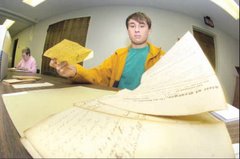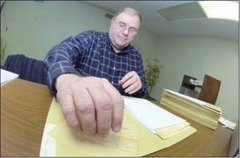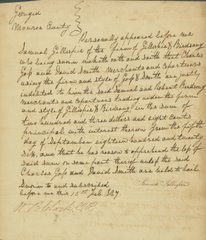DIGITIZING COUNTY RECORDS:
TROUP COUNTY COURT AND GOVERNMENT RECORDS
NHPRC INTERIM REPORT
NAR07-RD-10013-07
January 1 - July 31, 2007
Objectives:
a) flattening and scanning 53 linear feet of Troup County court records
b) Converting the Guide to Troup County Records to EAD and using automated scripts to create folder level records
c) Linking the scanned images to the folder level EAD records
d) Creating microfilm of the scanned images for long-term preservation
e) Testing the usability of the digitized materials with at least two focus groups and reporting on the results of the tests
f) Developing tracking methods to explore use of the digitized collection and compiling annual reports for at least three years after completion of the project
g) Developing a website that publicizes the project and describes the processes used at both the Troup County Archives and the Digital Library of Georgia
h) Publicize the project and its methods through press releases, announcements on appropriate listserves, articles in at least two publications, and presentation of the project during at least one professional conference.
Summary of Project Activities
The Troup County Scanning Project is proceeding according to plan. At this point, all 53 linear feet of materials have been flattened and prepared for scanning. Three linear feet of materials have been scanned in accordance with guidelines prepared by staff of the Digital Library of Georgia. Computer and scanning equipment has been purchased and is being used daily. Work has begun to convert the 1986 finding aid to Troup County court records to EAD.
Other activities have included hiring staff members to work at the Troup County Archives to scan the documents. The Troup County Archives staff has worked with the Digital Library staff to name and number image files to match the finding aids. Additionally a blog has been created to chronicle progress of the project.
Accomplishments
a) Flattening and Scanning: During the winter months of 2007, eleven people volunteered to assist in flattening the documents and prepare them for scanning. Volunteers were recruited through articles in the LaGrange Daily News and the newsletter of the Troup County Historical Society. Volunteers generally worked a minimum of two – 2 hour shifts per week (4 hours a week) and worked together in groups under the supervision of a staff member of the Troup County Archives. Flattening and other document preparation took 553 volunteer and staff hours to complete. Additionally, new archival boxes were purchased since flattened documents took up more space than the previously tri-folded materials. Our volunteers enjoyed handling the materials, some of which have only been looked at a few times in their 175 years of existence while others have been used and photocopied by Troup County Archives researchers on multiple occasions.
In mid-May, staff began scanning the flattened documents. By late summer, three linear feet have been scanned. Scanning has proceeded slowly to date, but we expect this part of the project to proceed more rapidly in the coming months. (The Troup County Archives had to move into temporary quarters while its building is being renovated. About two weeks scanning time was lost during this move since moving, setting up computers, and getting settled into the new space took several days longer than expected. Also, one of the original staff members was unable to work more than three weeks. Just after she started, her elderly mother was diagnosed with cancer. We were able to immediately employ an excellent recent graduate from LaGrange College and a new employee should start soon, but training each of these employees and getting them up to speed takes time.
Also during these early months, the original finding aid which was available only as a paper copy was scanned and saved as a word file. Given the numbers and the columns, this process took about fifty hours. This work was done by the project director but as a volunteer project during her off hours.
b) EAD Conversion
A consultant who works with the Digital Library of Georgia as her full-time job (Sheila McAllister) has begun the EAD conversion of the 1986 finding aid. She directed Archives staff on how to name the individual scans and documents. She did the sample page for the grant application and will begin working on the EAD conversion this fall.
c) Linking scanned images to EAD
In May, the project director plus one of the scanners (this person has remained on the scanning project since the earliest days of scanning) traveled to Athens, Georgia, and trained with the Digital Library staff. On that day, file names were established and have been consistently used so that the scanned images should link to the EAD finding aid once it is completed.
d, e, f) Creating microfilm, testing the usability of the digitized materials, developing tracking methods to explore use of the digitized collection and compiling annual reports will all be done in the coming months and have not yet been started.
g) Developing a website that publicizes the project and describes the processes used at both the Troup County Archives and the Digital Library of Georgia has begun and has been used to describe the flattening project. A blog has been created and has several articles on it. http://troupscanning.blogspot.com/ The blog needs to be updated with information about the actual time required for the flattening and with details about the scanning and EAD conversion. These articles will be added in the coming months. Also, more effort will be made to publicize the existence of the blog.
h) Publicize the project
The LaGrange Daily News has included two articles about the grant, including one top of the fold, front page article which was very helpful in getting volunteers. Additionally, the Troup County Historical Society newsletter has included articles. Finally, the project has been mentioned in the newsletter of the Association of County Managers and in an article in the Atlanta Journal Constitution about the IMLS “Preserving America” conference. An upcoming article in Annotations about the project is forthcoming. Copies of all these articles are included in this report. In future months, efforts will be made to have additional articles in the LaGrange, Atlanta, Columbus, and West Point newspapers plus in newsletters and journals of professional publications.
4. Assessment
The original goals of this project generally appear to have been realistic and we should be able to meet all of our goals, though we may have to ask for an extension of time. Everyone involves remains excited about the project and we are looking forward to researchers from various parts of the US and the world being able to use the documents via the Internet.
We also remain excited about this scanning project being a model for other scanning projects. We firmly believe that creating minimal metadata and spending minimal time processing the collection is an excellent way to do archival scanning projects. We are trying to follow this example in more of our processing projects at the Troup County Archives with both manuscript collections and with government records. Specifically, sometime in the next twelve months, we expect to significantly update and revise the Troup County Archives’ website (www.trouparchives.org). With the new website, we plan to include for the first time lists of government records and be ready to insert scanned pages as they become available. For instance, over time, we should be able to scan pages of Troup Inferior Court minutes. The Inferior Court heard both misdemeanor cases and acted as county commissioners in the early decades of Troup County’s existence. We could scan these pages and include only the briefest of descriptions about the minute books. We expect to do similar processing of manuscript collections and hope to include scanned images of some of our most popular collections. For example, we have a finding aid for the Julius Schaub collection. We appreciate Schaub’s excellent photographs made between 1881 and his death in 1910 and use them frequently. Many of our researchers get more excited about a company history he wrote of the NC Confederate military unit that he served in. Putting up scanning of his handwritten company history could help make this part of the collection much more accessible.
Three things have not gone according to expectation should have been expected: flattening and preparing documents for scanning took much longer than expected and hiring new staff members always seems to bring unexpected complications. We were delighted with how many people volunteered for our flattening project and that they stuck with the project until its completion. We plan to keep availability of volunteer time in mind for future project. In the past, we have had our greatest success getting volunteers for special projects, such as planning, organizing, and researching a tour of homes. We are delighted this flattening project worked so well, though we did not expect it to take as long as it did. The original estimate proved to be seriously low and it actually took about five times as long for the flattening and document preparation. Thank goodness for volunteers. Had the Troup County Historical Society and Archives had to pay for these hours, even at minimum wage, the project would have been over budget from the start. If we had it to do over again, we would have the staff member supervising the volunteers to have spent more of his time reboxing, making the shelf list, etc. while working with the volunteers. Instead, he spent most of the time the volunteers were here actually helping with the unfolding. This benefited the volunteers since they learned more about the actual documents than they would have otherwise, but it would have taken less of the Archives’ time if he had been doing other things while being available to answer questions.
As for staffing, the health of other family members meant that one of the first people hired had to quit and others had to be trained to do the scanning. Despite setbacks, scanning is progressing. We are very concerned about the slow speed of scanning and the fact that only three linear feet have been scanned; however, we expect this pace to pick up as staff becomes more use to the process. We are about to hire another person and should get the staffing stabilized. We should also be able to put one person to working on Saturdays so that more time will be spent scanning. We will also get Toby Graham, head of the Digital Library of Georgia to come to LaGrange and see if he has any recommendations for increasing the speed of the project. In general, we will try to speed up scanning as long as it can be done without hurting the quality of the scans.
All in all, we are satisfied with the project and excited about the end results. We hope scanning will proceed in coming months without complications and that the EAD conversion of the finding aid will be completed shortly. Then we will start setting up the DLG site with the scans and the finding aid and start making the materials available to the public.
5. Costs
Estimated costs:
Flattening the documents: 350 hours at $9.00 = $3150 (these hours were donated by volunteers) plus 200 hours by TCA staff at $19 per hour = $3800.
A total of 550 hours and an equivalent of $6950. went into flattening and document preparation. (Staff time was spent supervising volunteers, reboxing, reshelving, preparing new shelf list, labeling boxes, etc.)
Average cost per linear foot to flatten and prep $131.25 per linear foot.
(Note: $9.00 per hour was chosen because some of the volunteers had extensive professional experience in working with technology while others had no experience.)
Converting paper copy of finding aid to word file 50 hours at $33.00 per hour = $1650 (volunteer hours donated by the Project Director, work done on her own time.)
Scanning – basic cost has averaged $8.00 per hour. Additional costs include the scanner, computer and overhead. Thus far 232 hours have been spent scanning about 3 linear feet. Salary cost has been $1906. At this rate, it will take 3850 hours to finish the project. We will be working to spend up this process and get more scanning done more quickly. The current cost per page is 33 cents per page. We will be working to get this number down. The cost per linear foot is about $600. This is within the accepted range according to Harvard University’s website, using May 2006 figures (accepted is $150 to $750 per linear foot box) and these records are old and varying sizes. They certainly cannot be put through an automatic sheet feeder. Nonetheless, we will be working to speed the process along. For instance, every sheet does not have to be previewed when the sheets are the same size pages. We will be looking for other ways to speed the process but our options may be limited.
Metadata creation – unable to give an estimate at this point.
6. Impact
The impact of the project on the grant-receiving institutions, especially on the Troup County Historical Society, has already been significant. As mentioned above, staff at the Archives are reconsidering processing methods of larger collections and may begin scanning of collections, especially if this can be done without time consuming creating of metadata. Impacts beyond these two points will come in future months and years after the scans of court records are placed on the Internet.
Thursday, December 6, 2007
Subscribe to:
Posts (Atom)


